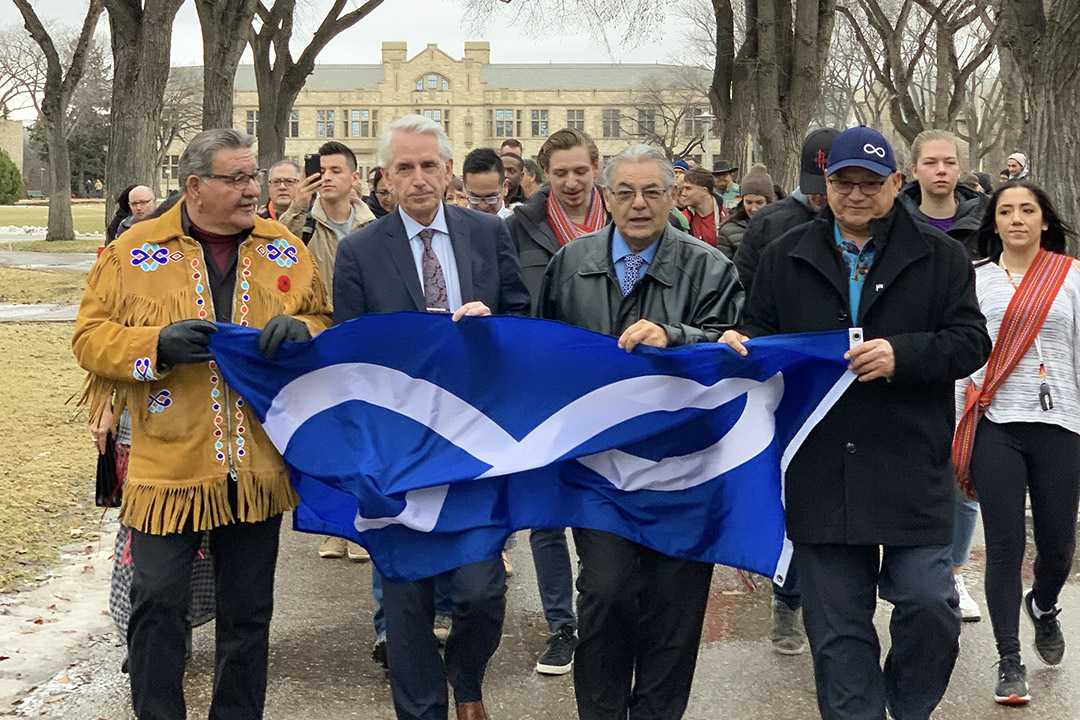
USask and Métis Nation–Saskatchewan sign education initiative
The University of Saskatchewan (USask) and the Métis Nation–Saskatchewan (MN-S) signed a Memorandum of Understanding (MOU) today designed to improve the education status of Métis people, remove barriers and close the university achievement gaps between Métis and non-Indigenous populations.
USask and MN-S committed to formalize, expand and enhance their relationship, work to identify common priorities and maximize mutual beneficial opportunities.
“This MOU shows our commitment to improve upon university academic programs and services currently in place or about to be established, through a collaborative and co-ordinated partnership for improving university education access, relevance, and achievement of Métis people and their communities within the University,” said USask President Peter Stoicheff.
“Métis Nation-Saskatchewan is proud of its commitment to post-secondary education,” said MN-S President Glen McCallum. “Under our 10-year, $89-million funding program, announced in July, almost 400 students already received funds and enrolled in class this fall.
“With continued community partnering, such as today’s announcement with the University of Saskatchewan, Métis youth can confidently follow the examples set by individuals like James McKay, Howard Adams and other Métis leaders, thinkers and achievers.”
Enrolment at USask continues to rise, with 3,320 Indigenous students on campus in 2018/19, an increase of seven percent. The university is also focused on increasing the number of Indigenous faculty, sessional lecturers and staff. In 2019, there were 217 self-identified Indigenous employees on campus.
“This MOU is another milestone in the ongoing development of our relationship with the University of Saskatchewan. Métis will have a stronger, more visible presence on campus, as we work on joint initiatives,” said MN-S Education Minister Earl Cook.
The MOU is designed to encourage and contribute to Métis presence and representation at all levels, including employment, governance, enrolment, completion rates, Métis-specific research, Métis studies and curriculum, cultural celebrations, Métis-specific symbols, naming and Métis community engagement. This MOU will also include partnerships, planning and sharing of ethical research initiatives that would advance the interest of the Métis Nation and residents of the province of Saskatchewan.
Indigenous peoples and culture have been an integral part of the university throughout its existence. Its work in innovative Indigenous programming, research and scholarship is built upon that connection—and to a handful of notable individuals who paved the way for the university that exists today.
Students of Indigenous descent were rare at institutes of higher education in Canada in the early 20th century. But USask welcomed its first Indigenous student just months after opening its doors. James McKay, a member of the original Board of Governors, was a noted Métis lawyer whose distinguished background served him well for 23 years in providing guidance and wisdom to the board as it grappled with managing the business affairs of the fledgling institution. McKay also has the distinction of being the first judge of Indigenous ancestry to be appointed to the court in Saskatchewan.
Howard Adams, a former professor in the Department of Native Studies at USask, was one of the most highly educated, outspoken and controversial Indigenous leaders of his time. Adams joined the RCMP shortly after graduating high school and went on to complete a bachelor’s degree, a teaching diploma, and a doctorate in the History of Education. He was the first Canadian Métis to earn a PhD.

